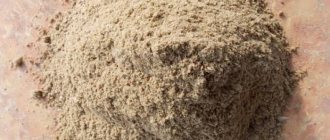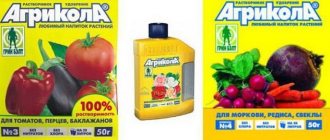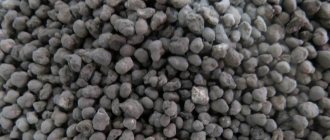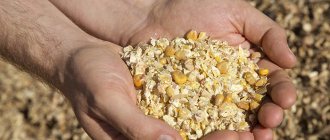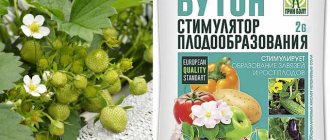What it is
Phosphorite flour is a natural mineral fertilizer. Its particles are gray or brown in color because they are sedimentary rocks. To produce this type of fertilizer, an industrial method is used. In the mountains, minerals belonging to the apatite group are mined, which were formed several hundred thousand years ago by organic bone deposits.
The rock is then cleared of clay and soil, brought to the surface and processed again. The next stage is grinding the “find”, resulting in a gray or brown powder. This fertilizer is environmentally friendly and natural. But groundwater does not wash it away.
Application
May be interesting The best herbicides against weeds for potatoes: list of herbicides, timing and application rules Ammophos fertilizer: characteristics and application features, reviews Superphosphate: properties, composition and instructions for using fertilizer
Phosphorite flour is used to increase the starch and sugar content in root vegetables and tubers, and to increase protein in the grain. This bait normalizes the level of phosphorus in the soil and helps plants better absorb potassium and nitrogen.
The use of flour also provides red soil and eroded black soil with microelements to reduce acid levels in the soil. But such procedures should be carried out before sowing.
The amount of fertilizer depends on the degree of phosphorus deficiency and the pH level of the soil. Basically, 0.5-2 tons of phosphorus flour is required per 1 hectare. There is no point in additional fertilizers, since the effect of fertilizing lasts up to 5 years. But you can mix it with organic fertilizer - flour increases their effectiveness. For example, you can use manure, compost, etc.
If the substance is used in the spring, then it should be applied during pre-sowing cultivation.
Description of phosphate rock
The key advantage of the product is its low price and long-lasting effect. Despite the fact that it is considered environmentally friendly, experts classify the drug as a moderately toxic substance.
Visually, phosphate rock resembles a gray crushed powder with an earthy tint. According to patented standards, 90% of the substance must freely pass through a sieve with a hole size of 0.18 mm. The higher the flowability of the drug, the higher the effectiveness of its use.
Flour loses its flowability when its moisture content is above 3.7%. This means that it is important to choose a dry place to store the substance and ensure that the packaging is sealed.
At the moment, 4 brands of phosphate flour are produced: A, B, B, C. With a mass fraction of phosphates A-29%, B-26%, B-23%, C-20%. The mass fraction of water is 1.5% and is recognized as standard for all brands.
The following physical characteristics are distinguished:
- The compounds are difficult to dissolve in weak acids and do not dissolve in water.
- Phosphorite flour is non-hygroscopic, dissipates well and does not caking.
- The liquidity benchmark is grinding fineness.
- The downside is that the fertilizer generates a lot of dust.
Phosphorus supports the vital activity of living organisms and agricultural plants, and the acid balance of the soil. The plant receives the substance from the soil in the form of soluble phosphates. If there is not enough phosphorus in the soil, organic and mineral fertilizers are used. Typically, manure, green manure, and composts are used.
Formula and composition
The flour formula consists of 4 substances: calcium (30%), phosphorus (17%), silica (18%), magnesium (2%), trace elements AL2O3, ZO2, SO2, F2O3, CuO. It is noteworthy that microelements are contained in the same proportions as in the soil.
The preparation process of the drug consists of 2 parts: enrichment with natural phosphorites, grinding of the resulting material.
Properties
Due to the similar chemical composition to the soil, the drug enriches the soil without harming it. If necessary, use flour to restore the pH balance of the soil. Due to its fine-grained structure, phosphate rock can be dissolved by weak acids. That is why, even in acidic soils, its absorption by plants is quite high.
The degree of digestibility depends on the acidity of the soil, the grinding of the drug and proper use. It is important to thoroughly mix the soil with flour when performing a cycle of soil enrichment measures.
Application
Flour is used to increase the sugar and starch content in tubers and root vegetables, and to increase the protein content in grains. Thanks to the use of phosphate rock, the balance of phosphorus in the soil is harmonized and the absorption of nitrogen and potassium by plants increases.
Phosphorite flour is used as a pre-sowing fertilizer on red soils and depleted chernozems in order to reduce their acidity.
Experts recommend adding flour during fall tillage by plowing. The plowing depth is from 20 to 30 cm depending on the type of plant. If non-oval processing is carried out, the backlog depth is 10-12 cm.
The amount of added flour directly depends on the degree of phosphorus deficiency and soil acidity, usually ranging from 0.5 to 2.0 t/ha.
The effect of the treatment is very long-lasting; it is enough to carry it out once every 3-4 years without adding additional fertilizers.
If you plan to use the substance in the spring, you must use the product for pre-sowing cultivation. It is important to note that the addition of phosphate rock during this period reduces the effectiveness of the drug by 30% in the first year.
One of the methods of application is a mixture with well-known organic fertilizers. Phosphorite flour increases the efficiency of manure, sapropel, compost and other organic fertilizers.
Signs of phosphorus deficiency
A lack of phosphorus is easy to notice. The leaves of the crop grow small, the veins become purple, which is a deviation from the norm. And the branches become more fragile.
During the formation of ovaries, the deficiency of this element is reflected by slow growth and shedding of the flower. Basically, in plants, negative changes in development begin with the lower leaves (the tops begin to curl), then the eyes and young shoots change.
In addition, there are other more common symptoms of phosphorus deficiency:
- leaves turn black and dry;
- the growing season becomes longer;
- vegetables, grains and other crops ripen later and grow more slowly;
- plant roots do not develop well.
Attention!
These symptoms are the most common, but there are other signs of phosphorus deficiency.
If these signs are noticed, it is necessary to apply fertilizer.
Plant needs for phosphorus and microelements
The use of phosphate rock will help avoid nutrient deficiencies in garden crops. Phosphorus fertilizers are necessary, since without this element the following is disrupted:
- Root growth. Without a well-developed root system, the plant will not be able to absorb nitrogen and gain green mass. With phosphorus starvation, buds on shrubs and trees do not bloom for a long time. If flowers appear, they soon fall off.
- Metabolism. It also depends on the capabilities of the root system. And since it initially could not form fully, further development, nutrition and fruiting are impossible.
- Foliage color. Due to poor nitrogen absorption, photosynthesis processes are weak. Chlorophyll, the green component of foliage, is not produced. Therefore, the leaves have a blue or purple tint.
- Taste qualities of fruits. The limited amount of potassium (again, the reason is in the roots) does not allow the fruits to convert nutrients into sugar, so they taste sour.
- Growth of young shoots. New branches grow after the root system develops. If the problem is in nutrients, or rather in their lack, there will be no growth.
An attentive gardener will immediately notice changes in crop growth and take measures to eliminate it as quickly as possible, before it affects the harvest.
Calcium in phosphate fertilizer
Another valuable substance in flour is calcium. Without calcium, all vegetable crops suffer - not only greens, but also fruits. With persistent calcium deficiency, the stem does not grow, the top dies off and the flowers fall off.
If calcium deficiency occurs when the fruits have already grown, then ripening and taste are impaired. The plant can be affected by fungal diseases, which affects the appearance of the fruit:
- tomatoes turn black;
- the cabbage becomes covered with necrotic spots or dries out;
- the pepper is rotting.
The plant dies if additional hairs through which nutrition occurs cease to develop on the roots. The root becomes covered with a slimy mass and rots, turning into a shapeless mass.
Silicon in phosphate fertilizer
A fairly high content of silicon in the form of oxide allows plants to extract the microelement in the summer, when the soil is well heated by the sun. When heated, silicon becomes available to plants.
The industry makes it easier for roots to feed by turning apatite into a finely dispersed substance, which, under certain environmental conditions, quickly gets to the plants “on the table”.
Silicon increases the density of the stem and its fibers. The microelement is especially important for grain crops - it develops their resistance to lodging.
Microelements of phosphorus fertilizers
The rich composition of microelements reduces the risk of fungal plant diseases. Soil pests are less active in the treatment area. Low pH promotes an increase in the number of pathological microorganisms. Alkalinization of the soil prevents them from reproducing.
Manifestations of phosphorus starvation in plants
In addition to phosphorus deficiency, there is also phosphorus starvation. These two symptoms are different, but the main signs of the latter are that the plants grow more slowly, the leaves are small in size and brown spots appear on them.
In addition, the leaves themselves can be very dark in color, often with a blue tint. Spots appear on fruits that have not yet reached the required degree of ripeness.
It is necessary to combat phosphorus starvation with superphosphate feeding. If the soil is acidic, then the use of phosphorites will be effective. To treat trees, you need to spray them with a solution, to prepare which, dilute 50 g of superphosphate in 10 liters of water.
Signs of phosphorus deficiency and excess in plants
Since phosphorus is one of the important nutrients, it is easy to notice its deficiency in various crops:
- Yellowing and whitening of leaves. Sometimes the color changes to red.
- The appearance of light spots on the leaves.
- Lethargy of stems.
- Insufficient number of ovaries and buds.
- Stunted plant and root growth.
- The fruits are falling.
- The leaves on the plant become smaller.
- Bald spots remain on the lawn.
- Roses have twisted stems. Leaves with a purple tint.
- Wheat, rye, and cereals become branched and grow slowly.
- Corn cobs are misshapen and underdeveloped.
- Potatoes have weak, few-branched shoots. The bush is compressed. During tuber formation, the leaves turn black and die. Red spots appear on the roots.
- Falling and reddening of leaves in tomatoes, their location at an acute angle.
- Thinning branches of an apple tree.
- Redness and bending of the edges of sunflower and tobacco leaves.
- Cabbage and rutabaga have purple foliage.
- Poor whisker formation in strawberries and wild strawberries.
- Sugar beets have weakened leaves with a blue tint.
The first signs of phosphorus starvation do not appear immediately, but only after 2 months. With a lack of phosphorus, old plants take it from their roots for some time, young plants cannot do this, they die.
If a lot of phosphorus fertilizers are added to the soil, this can also have a depressing effect on plants.
Signs of excess phosphorus:
- Leaves falling, yellowing, spots.
- Rapid aging of the plant.
- Increased water consumption.
- Interference with the absorption of nitrogen and potassium.
- Impaired absorption of iron and zinc.
- The plant ages quickly.
- Tomato leaves turn yellow.
Positive Features
The main advantage of phosphate rock is its long-lasting effect. One feeding is enough for about 5 years of action. The effectiveness of the fertilizer is not reduced. At the same time, it is not afraid of moisture, so it can easily tolerate watering and precipitation.
Phosphorus fertilizer does not sink into the lower layers of the soil along with the liquid. This aspect must be taken into account when distributing vegetable crops on the site. When planting plants with a deep root system, the fertilizer must be applied deeper.
Phosphorus flour can also be used to compost manure.
Bone flour
When phosphorus is extracted from organic compounds of biological origin, bone meal is obtained. Made from processed cattle bones, this fertilizer is actively used for all cultural plantings. In addition to phosphorus, bone meal is also a source of nitrogen and calcium and is ideal for feeding root crops such as potatoes, tomatoes and cucumbers.
To maintain and grow home flowers, bone meal is used more often than expensive phosphorus fertilizers. Its beneficial effect on large plants growing in a tub is especially noticeable. It is worth considering that compost, peat or manure is added in kilograms, bone meal must be calculated in grams or spoons.
Use of phosphorites
Feeding plants with this substance helps achieve:
- cultures are saturated with necessary elements;
- acidity in the soil has returned to normal.
Phosphorus flour can be used to feed cereals, fruits and vegetables. If it is applied to the soil, it is better to do it in the fall at the rate of 100-300 g per 1 sq.m. plot. For maximum efficiency, distribute this layer evenly, then dig the soil to a depth of 15 cm.
Phosphate flour is often used to increase the efficiency of using organic fertilizer. Basically, it is mixed with unripe compost in a ratio of 20 kg of phosphorites per 1 ton of fertilizer.
Magnesium sulfate
The fertilizer is available in the form of white or light gray fine-crystalline powder. It does not cake and does not absorb moisture, but can change its properties under the influence of sunlight. Contains about 17% magnesium and 13% sulfur. This substance may also be called magnesia and Epsom (bitter) salt. Its harmlessness is evidenced by the fact that magnesium sulfate is widely used in medicine.
Magnesium sulfate is not washed out of the soil with rain and watering and tends to accumulate in the soil, which ensures its long-term positive effect on plants.
Most of all, sandy and sandy loam soils and peat bogs need magnesium. Clay soils and loams are better provided with this element, so the addition of magnesium sulfate does not have a significant effect on increasing productivity.
The main application of fertilizer is best done before digging in spring or autumn. In the latter case, if magnesium sulfate is distributed in the tree trunk of fruit trees (up to 500 g) and berry bushes (up to 100 g), their frost resistance increases. In spring, you can add fertilizer to the holes when sowing seeds or planting seedlings (1 tsp each). In any case, the soil should be watered after applying the fertilizer so that it begins to work faster.
When applying fertilizer in bulk for most vegetable and flower crops, a dose of 12-15 g per 1 m2 is recommended. It decreases to 8-10 g for tomatoes and cucumbers and increases to 15-20 g for potatoes.
Advice
Practice has shown that it is best to apply magnesium sulfate together with nitrogen and phosphorus fertilizers - this ensures the greatest digestibility of the nutrients they contain.
Root feeding of all plants is carried out with fertilizer dissolved in water (25 g per 10 l) every half month. For foliar feeding, prepare a solution at the rate of 15 g of magnesium sulfate per 10 liters of water. Liquid consumption rates (per 1 m2): for vegetable and annual flower plants - 1.5, for berry and ornamental shrubs - 1.5-2, for young fruit trees - 2-3, for adults -5-10 l.
On a note
Potassium is a kind of competitor to magnesium in the soil. Its excess can negate the effect of magnesium sulfate and, conversely, magnesium interferes with the absorption of potassium by plants. Therefore, it is undesirable to mix these fertilizers, or to apply them after intensive feeding by the “rival”.
Magnesium sulfate has another feature: the higher the acidity of the soil, the less effective it is. Therefore, it is recommended to lime the soil in the fall and apply fertilizer in the spring. There is another option: instead of magnesium sulfate, use dolomite flour.
Reference by topic: Application of nitrogen fertilizers in ammonium form
Impact on grown crops
Phosphorite flour has a beneficial effect on almost all plants, but there are still crops that are characterized by poor absorption of phosphorus.
- buckwheat, mustard and lupine - these plants already contain large amounts of phosphorus, so they saturate the soil with the necessary elements;
- hemp, peas and sweet clover, sainfoin - contain large amounts of phosphorites, so the soil receives the necessary microelements. Crops absorb phosphorus well and then transform it into acids;
- cereals, potatoes, rice, beets - perfectly absorb phosphate rock, but on acidic soil. The difference between these plants is that they consume small amounts of calcium from the soil;
- flax, barley, millet, tomatoes, spring wheat, turnips - phosphorus does not take well from the soil. It is better to grow in areas with average acidity.
These nuances must be taken into account when choosing an area for planting.
Composition, properties and use of phosphate rock as a fertilizer
To date, scientists have developed and identified various fertilizers for growing plants.
As agricultural practice has shown, phosphate rock is considered one of the most environmentally friendly fertilizers. This fertilizer has a beneficial effect on the development, growth and productivity of grass crops.
However, it has its own individual application characteristics, which will be discussed in this article.
Description of phosphate rock
Phosphorite flour is a natural, mineral fertilizer. In appearance, it is a loose powder of a dusty gray or brownish-brown color.
Fertilizer production is based on sedimentary rocks, which consist of phosphorite homogeneous solids in a crystalline state.
They are mined with clay, sand and other secondary products of the earth's crust.
Compound
Phosphorite flour has many beneficial properties. It includes:
- phosphorus oxide - from 19 to 30%;
- silicon - 18%;
- calcium - 30%;
- magnesium - 2%.
In addition, flour contains a complex of microelements such as CuO, F2O3, AL2O3, SO2, ZO2.
Formula
The composition of phosphorus powder is dominated by phosphorus P2O5 and slightly soluble calcium salt Ca3. Its chemical formula can be expressed as Ca3(PO4)2.
The laboratory method for producing phosphorus flour involves combining orthophosphoric acid with calcium salts:
3CaCO3 + 2H3PO4 = Ca3(PO4)2 + 3CO2↑ + 3H2O
Or with calcium hydroxide:
3Ca(OH)2 + 2H3PO4 = Ca3(PO4)2 + 6H2O
As you can see, phosphorus flour has a difficult-to-digest formula for plants. However, this fertilizer works excellently on peat or podzolic soils, where the pH exceeds 7 units. The fact is that an acidic environment converts phosphorus into the form that plants need.
Properties
Phosphate flour is one of the most important fertilizers in crop production. When used, the powder has the following positive effects on plants:
- root formation;
- stimulation of tillering;
- accelerated growth process;
- winter hardiness;
- increase in yield.
But, despite such positive qualities, fertilizer also has its disadvantages. Phosphorus flour has increased water resistance.
Worth paying attention: Phosphorus flour has a long shelf life. It can be used once every 4–5 years.
Signs and manifestations of phosphorus deficiency
There are cases when plants stop growing in sufficiently nutritious soil that does not require fertilizers.
Many people involved in plant growing wonder what is the reason for this phenomenon.
It turns out that the main source of this phenomenon is free hydrogen ions, which accumulate in large quantities in the soil. Under their influence, the acidity of the soil increases and it becomes poorer in phosphorus.
To confirm this assumption, it is enough to pay attention to what wild plants grow on the site. As a rule, on medium and highly acidic soils you can see:
- oak grove;
- common sorrel;
- plantain;
- sphagnum;
- creeping buttercup;
- cotton grass;
- speedwell;
- cat's paw
In addition to these factors, increased acidity can be judged by cultivated plants. With phosphorus deficiency they experience:
- dryness and blackening of foliage;
- prolonged flowering;
- late ripening;
- growth arrest;
- underdevelopment of roots.
Another symptom of increased soil acidity is the red-violet color of plants.
Application of phosphorites
An important advantage of phosphate rock is that it can remain in the ground for a long time and gradually dissolve. In this regard, when using it, you can achieve a double effect, this is:
- Plants receive the necessary nutrients every year.
- The soil acidity level maintains the acceptable norm.
Moreover, the fertilizer is suitable for almost all cereals and fruit crops.
Standards for open ground
Phosphorus fertilizer is applied to open ground once every 5 years. The best period for this is considered to be autumn. This limitation is due to the fact that phosphorus will have time to get used to the soil over the winter, and in the spring it will begin to feed the plants.
Worth paying attention! If phosphorus flour is used to reduce soil acidity, additional organic matter will need to be used in addition to it.
Fertilizers are applied at the rate of 200–300 g per 1 square meter. m. For an effective effect, the flour must be evenly distributed throughout the entire area and dug up with soil at a depth of no more than 15 cm.
Standards for compost
Phosphate rock also improves the quality of fertilizers, which consist of a mixture of biological and organic substances, in the decomposition of which microorganisms participated. So, flour is added to unripe compost in a ratio of 20 kg per 1 ton. It will be enough to add 3 kg of phosphorus to the finished compost.
Plant needs for phosphorus and microelements
As mentioned above, phosphorus fertilizers contain a large number of useful elements. Let's look at the benefits they have on plants.
Calcium
Calcium plays an important role in plant development. In its deficiency, cultures lose their development.
As a rule, their growth stops, the top dies off, the inflorescences fall off, and fungal diseases develop. This negative impact reduces the amount of yield.
In addition, a lack of calcium affects the quality of the fruit. They lose their presentation, taste and shelf life.
Silicon
An element such as silicon contributes to the nutrition of plants with beneficial microelements found in the soil. The fact is that it crushes apatites to small particles, due to which they are better absorbed by herbal crops. At the same time, the plants become more dense and resistant to lodging.
Microelements
A rich complex of microorganisms has a beneficial effect on plant health. In the area where they lie, the development of pathogenic microorganisms is reduced. Due to this, herbaceous plants do not succumb to various diseases and become more resistant to the invasion of insect pests.
Despite the fact that magnesium in phosphate rock is only 2%, it is also worth noting in its benefits for plants. This microelement promotes energy production and has a positive effect on the quality of yield.
Impact on crops
As mentioned above, phosphate rock can be used for almost all types of crops. However, there are also plants that do not absorb phosphorus. Let's look at several of the most common types of crops and their relationship with phosphate rock.
Lupine buckwheat mustard
These green manures absorb sparingly soluble phosphates quite well. This is explained by the fact that they themselves are soil enrichers. When they are sowed, the physical and chemical properties of the soil improve. The earth becomes rich in organic matter and nitrogen.
Peas sainfoin clover hemp
The above plants, as well as green manure, interact with phosphorite. This effect is facilitated by the fact that crops have a significant release of acids through the root system. In addition, calcium predominates over phosphorite in their composition. Thanks to this, sparingly soluble phosphorite decomposes faster and turns into soluble salts.
Cereals flax beets potatoes vetch
This group of herbaceous and root crops absorbs phosphorus from phosphate rock only on acidic soils. This is because plants absorb small amounts of calcium. Accordingly, their root system does not produce enough acids to break down phosphorus.
Barley spring wheat flax tomato turnip millet
These plants do not tolerate acidic soil well. The conditions for their growth should be soil with a neutral pH. level.
Application on various types of soils
A distinctive feature of phosphate rock is that, depending on the soil, it is used as both a main and an additional fertilizer.
On acidic soils
Soil with a high level of acidity is very poor in potassium and phosphorus. Therefore, it conducts heat poorly and prevents plants from feeding nutrients. To reduce this negative impact, phosphate rock is applied to acidic soil as the main fertilizer once every few years.
When improving
Phosphorite flour can also be used on fertile soils. Here, as a rule, it acts as an additional fertilizer in improving the yield quality of fruit crops.
Features of use
Phosphorite flour, like any other fertilizer, has its own individual characteristics in use.
Methods of application
The effectiveness of phosphorite is affected by its correct application to the soil. To enrich and maintain the soil, fertilizers are applied in dry form. As a fertilizer, phosphate rock powder must be diluted with water and sprayed on the plants.
Dosages
The dosage of phosphate rock depends on the types of its purpose and the quality of the soil. To improve soil fertility, fertilizer is applied in the following doses:
- in soil of light mechanical composition - 0.8–1 t/ha;
- in soil with heavy mechanical composition - 2–2.5 t/ha.
If phosphorite is used as an additional fertilizer, it is diluted in water at a ratio of 20 g per 1 bucket.
What cannot be added to the soil at the same time
When using phosphorite, it is very important to consider its chemical properties. The fact is that this fertilizer is not compatible with some compounds. Among them are:
- chalk;
- dolomite and limestone flour;
- ash;
- slaked lime.
If these compounds have already been added to the soil, phosphorus can only be used the next year, since their combination will cause significant harm to the plants.
Security measures
Phosphorite flour is considered a fairly environmentally friendly fertilizer. However, it still contains toxins. Therefore, soil cultivation must be carried out strictly in work clothes, gloves, goggles and a protective gauze bandage. After the soil and plants have been treated, clothes must be cleaned of fertilizer residues, and hands and face must be washed with soap.
Differences between phosphate rock and superphosphates
Some novice gardeners believe that there is no difference between phosphate rock and superphosphates. However, they thereby make a big mistake.
Each of these fertilizers has its own value on certain types of soil. So, unlike phosphorites, superphosphates are not beneficial on acidic soil. But they are quite valuable on neutral and alkaline soils.
However, they are water-soluble and are applied only in liquid form.
Alternative replacement for phosphate rock
Plants can be grown on acidic soils without using phosphate rock. To do this, it will be enough to use mineral fertilizers that contain phosphorus. Such substances include:
- phosphate slag - phosphorus content 6–20%;
- precipitate - phosphorus content 27–48%.
These fertilizers are used only as pre-planting base material. As supplements, they are of no value.
As you can see, phosphorus flour is an indispensable assistant for every gardener. Using this fertilizer, you can restore the quality of the soil and significantly increase crop yields. However, do not forget about the rules and dosages of application. Large amounts of fertilizer can have a negative effect on plants.
Fertilizer using grass
This feeding option is one of the simplest and most effective. To prepare it, you can choose one of two recipes:
- water and grass;
- liquid, grass and nitrogen fertilizers.
The resulting fertilizer becomes accessible and nutritious. To saturate several acres of land with the necessary elements, only 200 liters of the resulting solution is enough.
How to cook:
- Collect the grass and chop it well - this approach will allow you to quickly prepare fertilizer. Mostly weeds or tops from the harvested crop are used;
- Place the prepared mixture tightly into containers and add warm or hot water in a ratio of 1 to 1;
- To speed up fermentation, substances that are a source of nitrogenous compounds can be added to the mixture. Thanks to them, bacteria multiply faster, and the fertilizer is more effective.
Attention!
You should choose waterproof containers: buckets, barrels and plastic canisters, etc.
Mix the resulting mixture and squeeze out the cake, which can be used together with the liquid. Experts advise using cake for mulching greenhouse plants, zucchini, cabbage, and pumpkin. It is also suitable for lining fruit trees.
The liquid turns out to be concentrated, so before use it must be diluted with water in a ratio of 1:2. It can be used to reduce the acidity of the soil and enrich it with fertilizers. It is better to water in the evening, after moistening the soil with plain water.
Security measures
Phosphate rock is a mildly toxic substance, but you should still follow certain safety rules when fertilizing the soil. To protect yourself, when working with fertilizer you should wear gloves, a respiratory mask, and special goggles. Exposed skin areas also need to be protected. After completing work with phosphate rock, treat all clothing, and wash the skin that came into contact with the fertilizer thoroughly with soap.
If the substance gets into your eyes, rinse them with plenty of water and then consult an ophthalmologist.
If the fertilizer gets into the respiratory tract, you need to quickly go out into fresh air and rinse your mouth with clean water. In addition, you need to take 1 liter of a solution of clean water and activated carbon orally, which does not allow toxins to enter the body.
Attention!
Keep the drug out of the reach of children and animals.
The shelf life of phosphate rock is as important as preventing temperature changes at the place of its storage.
What cannot be added to the soil at the same time
When using phosphate rock, it is important to take into account its chemical properties and compatibility with other mineral and organic fertilizers, since it is not compatible with all compounds. On the contrary, an incorrect connection can cause harm.
When applied to the soil, phosphorus becomes available to plants only when dissolved with weak acids. It is completely useless to use it on alkaline soils with a pH level above 7.5. Phosphorite flour works effectively only in conjunction with fertilizers that acidify the soil.
Tip #2. Do not mix phosphate rock with ash or lime-containing chemical compounds. At the same time, the solubility of substances in water decreases, and therefore their availability to plants.
Ash is incompatible with phosphate rock.
This is due to an insufficiently acidic environment, which is needed to convert phosphorus into food for plants. Just the opposite, the soil becomes alkalized in the presence of the following substances:
- Slaked lime (fluff),
- Dolomite flour,
- Limestone flour,
- Mela,
- Ashes,
- Crushed egg shells.
If these products were used, then phosphate rock can be added no earlier than after one year. In addition to acidity, it is important to take into account the final product, which is obtained as a result of the chemical interaction of phosphate rock with other mineral fertilizers. For example, when combined with superphosphate, an insoluble salt is formed, which turns into hard, useless lumps.
The difference between flour and superphosphates
If we compare superphosphates with phosphorus flour, the former have a more acidic reaction. Therefore, it is wrong to compare these two types of fertilizer. Each of them can be used in certain types of soil. It is more advisable to use superphosphate on alkaline or neutral soil. It contains a lot of sulfur, so it is used to feed plants that are deficient in this element.
The benefits of phosphate rock are more noticeable on acidic soil. This fertilizer is often used to restore fields after the use of mineral fertilizers and to increase acidity.
In some cases, superphosphates and phosphorus flour are used simultaneously. This approach is justified if you need to quickly dissolve phosphorites, and the fertilizers begin to complement each other.
Use of phosphate rock as a fertilizer, its composition and beneficial properties
To date, scientists have developed a large number of different fertilizers. Among them, phosphorite bait (flour) stands out, which can significantly accelerate the growth and development of the crop being grown. However, there are a number of features of the use of this fertilizer that need to be considered in detail by novice gardeners who have not previously encountered complementary foods.
Description of the fertilizer
Here we are talking about a natural mineral version of fertilizer. The flour components have a characteristic gray or brown tint. The loose powder is easy to use. This composition is extracted naturally from the soil, where certain products and substances have passed to the secondary stage of decomposition.
Flour composition
This natural product includes a number of useful substances and components:
- Phosphorus oxide (present in the composition from 19 to 30 percent).
- Calcium (the fertilizer contains about 30 percent of the component).
- Magnesium (complementary foods contain about two percent of the component).
- Silicon (usually this element is contained in 18 percent of phosphorus flour).
Additionally, such a composition for fertilizing vegetation contains a number of useful microelements.
Depending on the needs, the composition of phosphorus flour may contain additional components that have a beneficial effect on one or another factor when growing crops.
Product formula
The composition of this fertilizer is predominantly dominated by phosphorus, as well as a slightly soluble calcium salt. In theory, the chemical formula is as follows: Ca3 (PO4)2. If we talk about the reaction in which the main component of phosphorus flour is produced, it is as follows:
- 3CaCO3+ 2H3PO4 = Ca3(PO4)2 + 3CO2↑ + 3H2
Another formula can also be used to produce the component:
- 3Ca(OH)2+ 2H3PO4 = Ca3(PO4)2 + 6H2
Based on the extraction formulas, we can conclude that this substance is difficult to absorb by plants, which makes it possible to transfer useful substances to growing crops for a long time.
Properties of complementary foods
Phosphorus flour is characterized by the following beneficial properties:
- improved formation of the root system;
- stimulation of increasing the number of bushes;
- increased plant growth rates;
- improved resistance to low temperatures;
- increased fruiting of crops.
Despite many positive qualities, this complementary food is characterized by provoking stagnation of moisture, which is unfavorable for a number of vegetables and fruits.
In the process of complementary feeding, it is recommended to take into account the fact that the fertilizer has a long period of action, which is why it is used once every 5 years.
Phosphorus deficiency manifests itself in a number of symptoms. As a rule, pronounced symptoms include the following:
- plant leaves quickly dry out and turn black;
- the flowering period is greatly extended;
- late ripening of agricultural crops is detected;
- the crop stops growing;
- the root system develops poorly.
If these symptoms are present, then most likely you need to apply fertilizer.
Each individual vegetable or fruit, along with the main symptoms of phosphorus deficiency, may also exhibit other modifications.
Use of phosphorites
When using this type of complementary food for vegetation, it is possible to achieve the following effects:
- Vegetation receives the necessary nutrients.
- There is a regular level of acidity in the soil.
Phosphorus flour can be used as complementary food for all cereal crops, as well as fruit-bearing plants.
Soil standards
The most beneficial effect on the soil is the application of fertilizer in the autumn. The nutrient mixture is applied at the rate of 250 grams (on average) per square meter of soil. To achieve the maximum effect, you need to evenly distribute the layer, and then dig up the soil to a depth of 15 centimeters.
Required amount of phosphorus and trace elements
Without fail, for good growth and development, plants require a number of substances:
- calcium;
- silicon;
- microelements.
All these substances gradually disappear from the soil, which is why their gradual replenishment is required. Phosphorus powder is used for this.
Impact on grown crops
Phosphorus flour has a beneficial effect on almost all plants, but there are a number of crops that do not absorb phosphorus well.
Buckwheat, mustard and lupine
The cultivated crops themselves are a rich source of phosphorus for the soil, which is why they quickly take on beneficial properties from complementary foods. Growing these crops enriches the soil with essential microelements. After harvesting, the land is saturated with nitrogen and organic components.
The crops in question are also enriched with phosphorites, which is why their cultivation helps enrich the soil with micronutrients. The varieties absorb phosphorus well, and then process it into acids.
Cereals, potatoes, rice, vetch and beets
Such plants absorb phosphorus powder well only in acidic soil types. The difference is that the crops absorb small amounts of calcium (an element abundantly present in complementary foods).
Flax, barley, millet, tomato, spring wheat and turnip
These plant varieties do not take phosphorus well. For their fertility, it is necessary to use areas where the soil has average pH levels.
Growing on certain types of soil
In practice, phosphate rock is used as a main or auxiliary fertilizer. It all depends on the type of soil that is present on the site.
Acidic soil
This type of soil is characterized by a lack of phosphorus and calcium. Here it is necessary to use complementary foods as the main type of fertilizer. It is also allowed to use phosphate rock more often than once every five years.
Improving soil health
This type of complementary feeding can also be used on fertile lands as an auxiliary supplementary feeding. In this case, the use of the mixture is allowed no more than once every five years.
Application Features
This type of complementary feeding has a number of features that you need to pay attention to:
- options for introducing complementary foods;
- dosage of phosphate rock used;
- What should not be used to supplement complementary foods?
Experienced gardeners have repeatedly encountered the use of phosphate rock, which is why some recommendations have been made.
Use Cases
If you want to enrich the soil with microelements and useful substances, you need to apply the mixture in dry form. To provide complementary feeding, the powder is diluted in water, and then sprayed with it.
Dose of complementary foods
Depending on the composition of the soil, the dosage is calculated:
- light soil texture - 0.9 tons per hectare;
- heavy mechanical composition of the soil - 2.3 tons per hectare.
When using powder as additional complementary food, use 20 grams of fertilizer per bucket of water.
What cannot be supplemented
The following series of substances are not allowed to be added simultaneously with phosphorites:
- dolomite and limestone;
- chalk and ash;
- slaked lime.
If substances have already been added to the soil previously, it is recommended to use phosphorites the following year.
Precautionary measures
This type of fertilizer is an environmentally friendly product, however, it is recommended to carry out complementary feeding in protective equipment, since the composition still contains toxins.
Distinctive features of flour from superphosphates
Unlike phosphorites, the second type of fertilizer is successfully used on alkaline and neutral soils. It is not suitable for acidic soil. Also, superphosphates are dissolved in water and are not used dry.
Alternative replacement
Phosphorite flour can be replaced with mineral fertilizers:
- precipitate, in which the phosphorus content is 27-28%. Used as the main fertilizer before planting crops. It is not recommended to use it for feeding plants during growth and vegetation;
- phosphate slag – phosphorus content is 6-20%. Use as precipitate;
- superphosphate – 14-20% phosphorus. This fertilizer is used much more often than others. Cannot be combined with other fertilizers. Suitable for use on any type of soil, but on acidic soil, superphosphate can be applied only after preliminary neutralization.
Attention!
Fertilizer should be selected taking into account the needs of the soil and its type.
Adherents of organics prefer ash as a source of phosphorus. In addition to this element, it also contains sulfur, calcium, magnesium, boron, potassium, etc. You can use ash separately or together with other fertilizers, but not with phosphate rock.
Growing on certain types of soil
In practice, phosphate rock is used as a main or auxiliary fertilizer. It all depends on the type of soil that is present on the site.
Acidic soil
This type of soil is characterized by a lack of phosphorus and calcium. Here it is necessary to use complementary foods as the main type of fertilizer. It is also allowed to use phosphate rock more often than once every five years.
Improving soil health
This type of complementary feeding can also be used on fertile lands as an auxiliary supplementary feeding. In this case, the use of the mixture is allowed no more than once every five years.
Reviews
Olga, Zelenograd
For a long period I had a small harvest. What I haven’t tried to increase it: store-bought products, compost fertilizer. But there was no result, and twice I almost lost the fruit altogether. After this incident, I was looking for effective ways to save trees and decided to try phosphate rock. More than two years have passed since then, the trees are safe, and I am reaping a rich harvest.
Ivan, Smolensk region.
In my region, the soil is highly acidic, so phosphate rock is an effective way to combat it. There is nothing complicated in processing, so I don’t turn to specialists - I do everything myself. The optimal time for the procedure is early morning. In addition, I often make fertilizers from grass. Such fertilizing is not only profitable and effective, but also helps clear the area of weeds and old tops.
